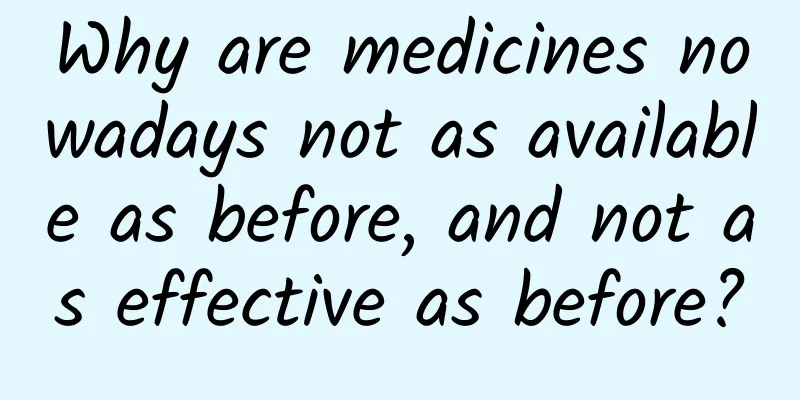Why are medicines nowadays not as available as before, and not as effective as before?

|
Perhaps in modern times when technology is more advanced, thinking has become an easier thing, but how to generate meaningful thinking is as challenging as ever. By Michael Bhaskar Compiled by | Wangwang The story of a scientific giant and a group of lucky chickens begins with 57-year-old Louis Pasteur and a group of lucky chickens. At the age of 57, Pasteur was already well-known in the scientific community. He probably didn't expect that one of his greatest achievements in life was just around the corner. He was studying chicken cholera at the time. When he was culturing Bacillus (the pathogen of chicken cholera), he accidentally forgot his culture in the laboratory. It was not until a summer later that he returned to the laboratory and found the remains. He injected the Bacillus into a group of chickens. Something unexpected happened: the chickens were thought to be infected with bacteria and seriously ill, but they all recovered. Pasteur guessed that this might be because the culture had expired after too long. So he conducted the experiment again and injected fresh bacteria into the recovered chickens and a new group of chickens at the same time. Once again, contrary to Pasteur's expectations, the two groups of chickens had completely different fates. The new group of chickens died of chicken cholera after receiving the injection, while the previously cured chickens were safe and sound again. Why this group of chickens was so "lucky" was beyond everyone's expectations, and various theories at the time could not explain this phenomenon. Pasteur gave his explanation: "This group of chickens had been vaccinated." The word "vaccine" was not unfamiliar to people at that time. The concept was known as early as the late 18th century. The English word "vaccine" comes from the cowpox used by Edward Jenner, and "vacca" is the Latin word for "cow". The cowpox vaccine successfully eliminated smallpox, which was raging on the earth at the time, but the principle behind vaccination had not been discovered until Pasteur had a flash of inspiration and saw the connection between the spoiled culture medium and immunity. Although everyone knew about vaccination, only he went deep into it and tried to uncover the mechanism behind it, and thus made a decisive breakthrough. Pasteur's most well-known saying is "Chance favors the prepared mind." Maybe flashes of inspiration are not uncommon, but what is rare is that there are people like him who can be prepared when that flash of inspiration comes. Louis Pasteur (1822-1895), the founder of modern microbiology "It's a favorite thing to watch." ——Louis Pasteur We can see that vaccination is a trick discovered by chance. At first it was not controllable and difficult to apply to other diseases. Pasteur discovered the connection between immunity and the seemingly "broken culture medium". He was so excited that he couldn't sleep because he saw the hope of applying vaccination to other diseases. In 1878, Pasteur successfully developed a chicken cholera vaccine. He then turned his attention to anthrax, a zoonosis caused by Bacillus anthracis. When experimenting with Bacillus anthracis, he and his research team found that culturing a weakened version of the bacteria could produce offspring with the same weakened version. Based on this, they successfully cultivated an attenuated version of Bacillus anthracis and developed an anthrax vaccine based on it. In February 1881, Pasteur announced his research results: anthrax, a plague once recorded in the Egyptian Bible, a terrible livestock disease, can be controlled and is no longer invincible. After this battle, Pasteur was full of confidence and continued to develop a rabies vaccine. This was a project that was very meaningful to Pasteur personally. When he was a child, a wolf had wreaked havoc in his hometown, killing eight people. As one of the diseases with a very high mortality rate at the time, rabies was almost impossible to cure until Pasteur began to try. To do this, he needed to study a microorganism that had a longer latent time and was more difficult to detect - later, people named this smaller microorganism "virus". Although there was no technical means to directly observe viruses at the time, after repeated attempts and referring to the method of making attenuated bacteria, Pasteur successfully found a way to build immunity. His first experimental subject was an eight-year-old boy bitten by a rabid dog. From now on, it seems very risky and unconventional to conduct experiments on humans too early, but at that time, people could only watch the little boy go to the end of his road without any other choice except to take a risk. Pasteur speculated that vaccination would work before the month-long incubation period, so he needed to inject the weakened virus into the little boy before he showed symptoms. This was a risky attempt, and although Pasteur knew that his experiment might make the situation worse, he was nervous but determined, starting with a small dose, and after 12 rounds of attempts and weeks of sleepless observation, he finally succeeded. The development of events did not end there. Pasteur is called a giant in the medical field, not only because he successfully developed vaccines. In fact, Pasteur's vaccination technology was just a climax in this technological explosion. After that, a series of medical breakthroughs followed, including the theory of disease bacteriology, pasteurization technology, the understanding of sepsis and the necessity of clinical cleaning, vaccination for rabies and anthrax, and the understanding of the tiny interactions of the entire microbial world... It is for this reason that Pasteur is called the founder of modern microbiology. Just like Newton opened up classical mechanics, Pasteur opened up the field of microorganisms and created a whole set of unique basic research methods in microbiology. Under the simple conditions at the time, the breakthroughs that started from him were like lighthouses that illuminated the world. These great ideas shuttled back and forth between practical problems and theoretical science, and ultimately changed mankind's comprehensive cognition in knowledge, medicine, health and even morality. One light after another lit up, dispelling the darkness that once blocked mankind. Without these breakthroughs, we cannot imagine where the modern world would go. Source: 1freewallpapers.com Pasteur's scientific attempt from practice to theory and finally back to practice reveals a pattern that we are now accustomed to: some great changes often involve two levels, knowledge and technology, and form a virtuous circle between the two. But knowledge and technology always fight side by side with the problems they face. In this struggle, Pasteur's achievements gave us an advantage. More than a hundred years have passed in the blink of an eye. How many "Pasteurs" are still working today? The "Pasteur" here does not refer to people who are engaged in medical research or microbiology research, but refers to how many works can have such a profound impact as Pasteur's work. Some people believe that there are fewer "Pasteurs", but one of the reasons why Pasteur achieved so many achievements was that he happened to stand at the starting point of a knowledge explosion; others believe that our work has indeed increased, but the breakthroughs with the same influence as Pasteur's work have decreased. Perhaps in modern times with more advanced technology, thinking has become an easier thing, but how to generate meaningful thinking is as challenging as ever. The Golden Age of Medicine, where everything is possible and full of hope Since the 19th century, human life expectancy has greatly increased, supported by a series of explosive technological growth in medical science and public health. In 1907, the first pharmaceutical product in human history, Salvarsan (arsenic phenamine), was born. This is a drug used to treat syphilis. Its arrival opened up a new way of treating diseases for humans - chemotherapy. Three and a half years later, an even greater breakthrough appeared: the discovery of penicillin and the subsequent era of antibiotics and mass medicine. The door to the unknown was slowly pushed open. This was the first such breakthrough in human history. We ushered in a period of great development in which medical capabilities and medical methods have continuously and regularly made breakthroughs. We can even say that mankind has entered the golden age of medical research. In the words of the famous physician and author Seamus O'Mahony: "For most of history, the power of medicine was very limited, but suddenly it became magical. The 50 years from the mid-1930s to the mid-1980s were like the golden age of medicine. Everything was possible and everything was full of hope." He was not exaggerating. The discoveries of this period were numerous: we can kill bacteria that were once invisible. We can perform visible heart surgery; we can transplant organs and perform in vitro fertilization; we can prevent pregnancy with a small pill; we can even use various means to save a life lying on the verge of death in the intensive care unit; we have also eliminated or controlled infectious diseases that are very harmful to humans, such as polio and smallpox. At the same time, the life expectancy of human beings, which had been stagnant for a long time, began to grow. Take Europe as an example. The average life expectancy of Europeans was only about 20 years old before the Common Era. After nearly two thousand years, it reached 40 years old in 1850. In the following 100 years, this number has grown rapidly. According to the report of the World Health Organization in 1977, it has reached 72 years old. With the progress of medicine, the concept of "public health policy" has been widely mentioned. Public health has improved on a large scale. Human beings have gradually established basic sanitary facilities in cities and started to use private indoor toilets. The transition from horse-drawn carriages to cars has made the roads cleaner and tidier. The number of hospitals has increased, and doctors have become more knowledgeable. While drugs have gradually entered the market, food has also been more strictly regulated. Human consumption patterns have improved. We have ushered in a more ideal world, a world with better living conditions, cleaner cities, more complete medical conditions, and a safer and more ideal world. This is a remarkable change. These amazing changes continued to occur until the second half of the 20th century, but the pace of change slowed significantly. Early medical breakthroughs focused on saving young lives, and these advances saved many families from tragedy. Over time, the focus shifted to the elderly. By the year 2000, the pace of progress had been halved, but the achievements were still amazing. In the UK, US, France, Germany and other countries, there are early signs that life expectancy is no longer increasing and is even declining. In the US, for example, life expectancy has continued to decline between 2015 and 2020, the largest drop since World War I and the Spanish flu. In the UK, life expectancy has slowed significantly since 2011, with no progress since 2015. We can expect these figures to fall further after the coronavirus pandemic. These phenomena point to the fact that at the forefront of our science, there are no more Pasteur-like breakthroughs and drugs no longer work as miraculously as they once did. Eroom's Law, the epitome of a pessimistic future Drug discovery follows Eroom's Law, which simply states that as time goes on, the same amount of money spent on breakthroughs gradually decreases. For the same $1 billion spent on research and development, the number of approved projects will be reduced by more than half every nine years. Drug development has followed this pattern for nearly 70 years. Compared with 1950, the cost of drug development has risen by as much as 80 times. Research from Tufts University in the United States shows that from 1975 to 2009, the cost of developing a drug that can be approved by the FDA increased by at least 13 times. In the 1960s, the cost of developing each drug was about $5 million, but after 2000, this figure had grown to $1.3 billion. The time required to develop each drug has also been greatly extended (at least before the COVID-19 pandemic). Eroom's Law tells us that if we want to develop a new drug, we need to spend more and more time and money, which means that it is becoming increasingly difficult to achieve breakthroughs in drug development. Who is Eroom? No, it is not a person's name, but Moore spelled backwards. Moore's Law predicts that the number of transistors in a chip will double approximately every two years, which will drive exponential growth in human computing power. It reflects the accelerated change in technology and is a representative of technological optimism. Eroom's Law observes the norm in the pharmaceutical industry, where the speed of human development is difficult to increase, but the challenges encountered are getting bigger and bigger. In the 1880s, the demand for new drugs continued to grow, but the increasingly difficult research and development trend made people feel that the golden age of medical development had passed. As Seamus said, "This is an era with many unfulfilled and unrealistic wishes, an era destined to disappointment." At present, the hot spots of drug research and development are mainly concentrated in two areas: rare diseases and chronic diseases. There is an urgent need for new drugs in these two areas, and the investment in them can provide stable and predictable returns. These serious and common diseases are gradually under control, but diseases such as the common cold still threaten humanity. At the same time, drug research shows a trend of losses, and it is not a good sign to spend more than you earn. Every year it takes more money, researchers, time, and effort to achieve breakthroughs. But this trend is very difficult to understand. It goes against a basic consensus: large-scale upgrades in technology and investment should bring more output. We have maintained the pace of basic science and technological means. From the 1980s to the 1990s, chemists had the technology and equipment to increase the number of drug molecules they could synthesize by 800 times. Especially in the field of medicinal chemistry, compound libraries have replaced individual compounds and become the basic component of drug research, which has developed rapidly. The technical tools we have are also being updated. For example, DNA sequencing technology has improved nearly 1 billion times compared to when it first appeared in the 1970s; we have more powerful computing power support, drug design assistance technology, protein structure analysis technology to pave the way for us to discover new drugs. Our investment in new drug research and development is also increasing. Health-related R&D funds account for 25% of all R&D expenditures, far higher than 7% in the 1960s. From both a scientific and economic perspective, drug discovery should be a shorter and less expensive thing. But the opposite is true. Eroom's law also runs counter to the model of Pasteur's time, which may mean that we are facing an increasingly severe challenge. With each passing year, we need to invest more money, researchers, time and energy to promote progress. This is a dilemma we all face. It is firmly trapped in each of us. Our family, friends, our loved ones, and our basic quality of life are closely related to it. When one day our loved ones lie in bed, perhaps we will think more urgently about these questions, why medical progress is so important but so difficult. Looking back at the history of humanity’s struggle against cancer, we may be able to see how difficult it is to make a breakthrough. In developed countries, 50% of people will be diagnosed with cancer in their lifetime; there are 17 million more cancer patients worldwide each year, and it is expected that this number will grow to 27.5 million by 2040. Despite this, there has been no major breakthrough in cancer treatment. There are currently three main treatment options for malignant tumors: surgery, radiotherapy, and chemotherapy. There are many drugs for cancer, some of which are expensive but generally ineffective, and some have many adverse reactions. According to a study published in the Annals of Oncology, only 18 of the 47 anti-tumor drugs sponsored by the US NHS Special Fund can improve the survival rate of cancer patients, but the effect is not significant, and the average increase can only be about 3 months. Other drugs not only have no effect, but also have side effects that are extremely harmful to the human body. But there is also some encouraging good news. The recent rise of immunotherapy may bring new hope to the "war on cancer", and some researchers even compare it to the discovery of penicillin - a turning point that could have a profound impact on the field and save countless lives. The development of immunotherapy is based on modern science's in-depth understanding of the immune system and molecular biology, targeting T cells (a type of lymphocyte). In the past 30 years, researchers have realized that T cells can selectively recognize and kill pathogens or abnormal cells. Normal cells have many checkpoints to ensure that they are not accidentally injured by immune cells in autoimmune reactions. Cancer cells also have similar checkpoints, which allow them to evade the clearance of the immune system and proliferate rapidly in the human body. If scientists can reveal the true face of cancer cells, then T cells and other immune cells can play their due functions and fight against cancer cells, which is one strategy of immunotherapy. Another strategy of immunotherapy is to sample and redesign the body's T cells to attack specific cancers and then reintroduce them into the patient's body. These cells are also called CAR-T (chimeric antigen receptor T cells), and this type of therapy is also very promising. (See: Under the microscope, see the battle of wits and courage between immune cells and cancer cells | Touching the elephant) Immunotherapy is developing rapidly. In 2015, former US President Jimmy Carter received experimental immunotherapy for cancer and announced that he had successfully defeated melanoma. In 2018, American scientist James Allison and Japanese scientist Tasuku Honjo won the 2018 Nobel Prize in Physiology or Medicine for "discovering cancer therapy brought about by negative immune regulation." The breakthroughs in immunotherapy show that the degree of human understanding of problems has changed, gradually shifting from focusing on superficial symptoms to solving more complex and changeable biological essences. From the above, immunotherapy seems to be a wonderful breakthrough, but in fact, for a long time, immunotherapy was not favored by people. After it was first proposed in the late 19th century, most scientists believed that it was nonsense that the immune system could fight cancer. They did not believe that cancer cells could be recognized as invaders by the immune system. After that, immunotherapy went through a long gestation period. Although it was initially questioned, the work on immunotherapy continued to move forward as planned. The Time magazine published on March 31, 1980, with cancer treatment as the cover article theme, called interferon "penicillin for cancer" to describe the unproven immunotherapy at the time, but behind such high-profile praise, there was a stagnation. People lost confidence and believed that immunotherapy lived up to the publicity and was simply hype. The experimental results were good and bad, and there was no consistent and clear conclusion, which also made investors at the time begin to waver, and even some people who once firmly believed in immunotherapy began to doubt. source: At the same time, the number of cancer studies has increased dramatically and the cost is huge. In the past 50 years, no other type of research has spent as much money as the cancer field. In 1971, then-President Richard Nixon signed the National Cancer Act of 1971, launching the first attack on cancer. People were full of expectations, believing that such a large-scale battle would make curing cancer a piece of cake. In particular, the successful cure of childhood acute leukemia by "combination chemotherapy" in the 1960s deepened people's expectations. Researchers even believed that we could completely conquer cancer in 1976, just in time for the 200th anniversary of the founding of the United States. Yet, all expectations were dashed. Although there were improvements in cancer patient care, the expected quantum leaps did not occur. This did not mean that the researchers were not doing good work; it simply highlighted the magnitude of the challenge they faced. The stagnation made it clear that breakthroughs would require a deeper understanding of the biology of cancer and immunity, as well as more funding from the NIH. Against this backdrop, immunotherapy has made a breakthrough. The first immunotherapy was approved by the FDA in 1992, but it did not cause a sensation at the time. It was still a marginal therapy, and no pharmaceutical company dared to take this risk before achieving the desired therapeutic effect. The wavering attitude of pharmaceutical companies has made the road to immunotherapy full of ups and downs. Despite funding from the NIH and other institutions, the road ahead is still bleak and the challenges are still huge. First, frontline research data show that the results of clinical trials are mixed: immunotherapy seems to be effective only for certain cancers and patients, which makes frontline clinicians more cautious about immunotherapy. Secondly, there are a large number of immunotherapies under research. As of 2019, more than 2,000 immunotherapies are in the preclinical or clinical trial stage, but this blowout growth has brought new problems: there is not enough room in the market to accommodate the development of these therapies, and the investment boom may dissipate prematurely. Another problem is that immunotherapy is too expensive, generally costing hundreds of thousands of dollars; Novartis' CAR-T therapy costs $475,000 per patient. Finally, people still have doubts about its efficacy, and it is not yet known how many people can be cured by immunotherapy in the short and medium term. (See: It has been 9 years since the first success of tumor immunotherapy. Where is it now?丨Touching the Elephant) Undoubtedly, immunotherapy is very important. Its emergence has brought hope to many patients. It is a powerful attack on cancer and the frontier of medicine. However, we cannot ignore its problems and the difficulties it faces. It is still deeply trapped in the pattern of Eroom's law. A careful analysis of its difficult development process will help us understand how the current medical breakthroughs will occur. The future is not only full of unknowns, but also full of great ideas. The emergence of immunotherapy is not a sudden stroke of luck. Just like mRNA vaccines and some other successful cases, in addition to sufficient financial and personnel investment, these breakthroughs have also gone through a long period of gestation, countless dead ends, and countless missed opportunities. It means that many researchers are facing marginalization, being looked down upon, being questioned, and even a life of searching but without results. In Pasteur's time, researchers relied on a basic laboratory and the collaborative work of several assistants to make great breakthroughs; in the 1830s and 1840s, Fleming, Chain, and Florey successfully discovered penicillin with the support of a university department and a research hospital; and in modern times, we are trying to conquer cancer, which requires thousands of researchers in cutting-edge laboratories around the world to work together. Source: nobelprize.org The 1945 Nobel Prize in Physiology or Medicine was awarded jointly to Sir Alexander Fleming, Sir Ernst Boris Chain and Sir Howard Walter Florey "for their discovery of penicillin and its efficacy against various infectious diseases". From Pasteur's rabies vaccine to Pfizer's mRNA vaccine, humans have made amazing breakthroughs at different stages, and all of this has become increasingly challenging. Pasteur made remarkable breakthroughs in a situation full of unknowns, scarce resources, underdeveloped tools, and a lack of theory. It can be said that there is no one before and no one after. When we return to modern society, although the challenges we face are infinitely magnified, we are equipped with better scientific research conditions and stronger scientific research teams. We believe that somewhere, there is another Pasteur, or even many Pasteurs who are working silently with their heads down, waiting for their moment of inspiration. Eroom's Law does not only reflect the current situation of the pharmaceutical industry, it may reflect a normal state: in our current world, the problems left for us to solve are at a higher level, and with our continuous progress and accumulation, we will surely make a breakthrough at some point. The future is not only full of unknowns, but also full of great ideas. Compiled from: https://thereader.mitpress.mit.edu/breakthrough-problem-erooms-law/ Special Tips 1. Go to the "Featured Column" at the bottom of the menu of the "Fanpu" WeChat public account to read a series of popular science articles on different topics. 2. Fanpu provides a function to search articles by month. Follow the official account and reply with the four-digit year + month, such as "1903", to get the article index for March 2019, and so on. Copyright statement: Personal forwarding is welcome. Any form of media or organization is not allowed to reprint or excerpt without authorization. For reprint authorization, please contact the backstage of the "Fanpu" WeChat public account. |
<<: How to eat takeout more healthily?
Recommend
A demonstration of user growth from Pinduoduo and Douyin!
The 2019 New Year’s Eve concert has just ended. T...
After 8 years, 16 Crested Ibis returned home! Why did they go abroad?
"The graceful crested ibis comes to the spri...
10 operational activities to teach you: How to take advantage of the World Cup
The World Cup period is a good time for major pro...
Why is the luxury cat bed you bought for 800 yuan not as good as a broken cardboard box for express delivery?
Today is a very interesting festival - the annual...
91 Ten Articles - Tesla builds data center in China, NIO joins hands with Sinopec to bet on second-generation battery swap stations
1. Juefei Technology has received another round o...
Experts say that the fabrics of Bosideng's 10,000-yuan down jackets are very cheap? Where is Bosideng heading to the high-end market?
In recent years, with the continuous improvement ...
What happens to people who often wear high heels?
Do you remember what it was like when you first w...
Annals of Internal Medicine: Study finds people who sleep late have a 72% higher risk of diabetes
A large study of middle-aged nurses found that th...
How much meat is in the "starch sausage" that costs 2 yuan on the street? The answer is guaranteed to surprise you!
Who would have thought that the starch sausages s...
Is it really dangerous to exercise after staying up late?
Fitness is undoubtedly a good habit. Drink a cup ...
Apple Internet TV requires TV stations to stream their own videos
In its cooperation with Hollywood and the music i...
Screen prices fall to the lowest level in two years. Are good days coming for TV manufacturers?
Panel prices, which have been falling since the s...
Inquiry on the investment price of Bozhou Moving Mini Program. How much is the investment price of Bozhou Moving Mini Program?
Starting a business requires costs, and mini prog...
China Anesthesia Week丨The Guardian of "Intoxicating" Beauty: Let's Learn About the Mysterious "Anesthesia Clinic"
The last week of March 2025 is the 9th "Chin...
Is the cost of joining the Jiamusi Beauty Mini Program high? Jiamusi Beauty Mini Program Franchise Fees and Process
How much does it cost to join a beauty mini progr...









